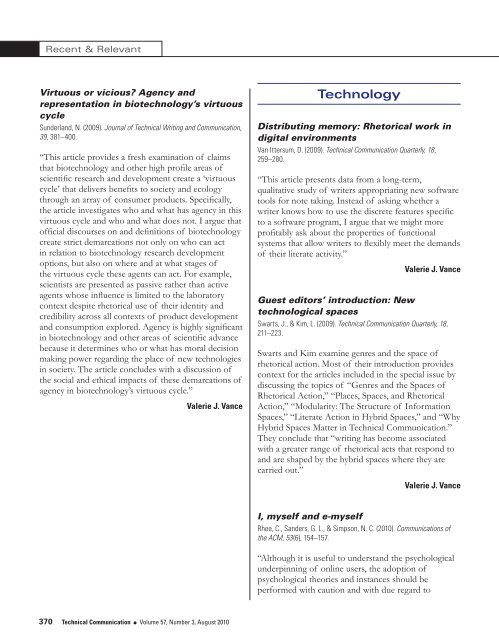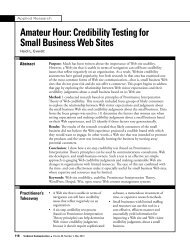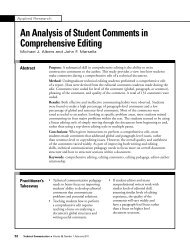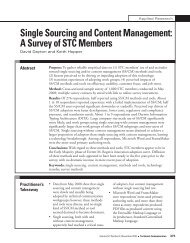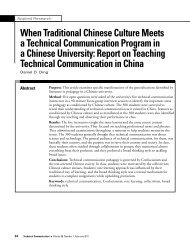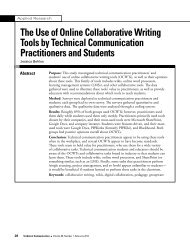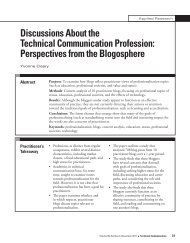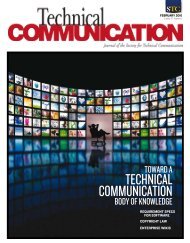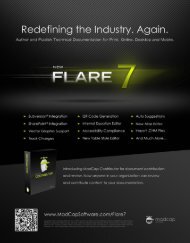Recent & RelevantVirtuous or vicious? Agency andrepresentation in biotechnology’s virtuouscycleSunderland, N. (2009). Journal of Technical Writing and Communication,39, 381–400.“This article provides a fresh examination of claimsthat biotechnology and other high profile areas ofscientific research and development create a ‘virtuouscycle’ that delivers benefits to society and ecologythrough an array of consumer products. Specifically,the article investigates who and what has agency in thisvirtuous cycle and who and what does not. I argue thatofficial discourses on and definitions of biotechnologycreate strict demarcations not only on who can actin relation to biotechnology research developmentoptions, but also on where and at what stages ofthe virtuous cycle these agents can act. For example,scientists are presented as passive rather than activeagents whose influence is limited to the laboratorycontext despite rhetorical use of their identity andcredibility across all contexts of product developmentand consumption explored. Agency is highly significantin biotechnology and other areas of scientific advancebecause it determines who or what has moral decisionmaking power regarding the place of new technologiesin society. The article concludes with a discussion ofthe social and ethical impacts of these demarcations ofagency in biotechnology’s virtuous cycle.”Valerie J. VanceTechnologyDistributing memory: Rhetorical work indigital environmentsVan Ittersum, D. (2009). Technical Communication Quarterly, 18,259–280.“This article presents data from a long-term,qualitative study of writers appropriating new softwaretools for note taking. Instead of asking whether awriter knows how to use the discrete features specificto a software program, I argue that we might moreprofitably ask about the properties of functionalsystems that allow writers to flexibly meet the demandsof their literate activity.”Valerie J. VanceGuest editors’ introduction: Newtechnological spacesSwarts, J., & Kim, L. (2009). Technical Communication Quarterly, 18,211–223.Swarts and Kim examine genres and the space ofrhetorical action. Most of their introduction providescontext for the articles included in the special issue bydiscussing the topics of “Genres and the Spaces ofRhetorical Action,” “Places, Spaces, and RhetoricalAction,” “Modularity: The Structure of InformationSpaces,” “Literate Action in Hybrid Spaces,” and “WhyHybrid Spaces Matter in Technical Communication.”They conclude that “writing has become associatedwith a greater range of rhetorical acts that respond toand are shaped by the hybrid spaces where they arecarried out.”Valerie J. VanceI, myself and e-myselfRhee, C., Sanders, G. L., & Simpson, N. C. (2010). Communications ofthe ACM, 53(6), 154–157.“Although it is useful to understand the psychologicalunderpinning of online users, the adoption ofpsychological theories and instances should beperformed with caution and with due regard to370 Technical Communication l Volume 57, Number 3, August 2010
Recent & Relevantapplicability. Many Web developers start with thepremise that an individual’s perceptions, thoughtsand online behaviors are similar to their personalityin the real world. However, if this premise itself iswrong—that is, if an individual becomes a differentperson when online, then our theories along with ourbusiness strategies may require modification. It is ourposition that study of the development of the virtualpersonality is vital because human beings perceive,think, and behave differently when they are online.”Sherry SouthardIndividual resistance to IT innovationsJoseph, R. C. (2010). Communications of the ACM, 53(4), 144–146.“Possibly, more important than the intention toadopt, is the intent ‘not to adopt’ a new technology.IT innovations are complex and content-sensitive anddiffer across a variety of factors including features,usability, and connectivity. If companies can betterunderstand the non-adopter, they can use creativestrategies to move such individuals into the adoptercategory, which can ultimately increase productvisibility and revenue generation.”Sherry SouthardInformation, architecture, and hybridity:The changing discourse of the publiclibraryCarnegie, T. A. M., & Abell, J. (2009). Technical CommunicationQuarterly, 18, 242–258.“In an industrial society, the library is associated withmodern economic, political, and social metanarratives.With the rise of digital technology, public libraries arethreatened with the possibility of becoming obsoleteand irrelevant. Spaces and interfaces intersect withmodern and postmodern narratives as the library viesto establish its identity as a legitimizer and purveyorof knowledge in the information age. Througharchitecture, the library comes to speak the languageof hybridity to reassert its relevance and repositionitself.”Valerie J. VanceNew search challenges and opportunitiesSavage, N. (2010). Communications of the ACM, 53(1), 27–28.“[T]he type of content [of the web] is expandingdramatically, with blogs and Twitter feeds, maps andvideos, photos and podcasts …. For search engines,this enormous variety of data and formats is providingboth new challenges and new opportunities.” Savagediscusses very briefly some of the issues and research.Sherry SouthardTo scroll or not to scroll: Scrolling,working memory capacity, andcomprehending complex textsSanchez, C. A., & Wiley, J. (2009). Human Factors, 51, 730–738.“The purpose of these experiments was to examinethe effects of user characteristics on learning fromscrolling interfaces …. Although scrolling Web pagesare now common, few studies have explored theeffects of scrolling on understanding the content thatis being conveyed …. This set of studies investigatedwhether presenting text in two particular formats hasan effect on comprehension for readers who differin working memory capacity …. Results from bothstudies indicated that a scrolling format reducedunderstanding of complex topics from Web pages,especially for readers who were lower in workingmemory capacity …. These findings show that theway text is presented can interact with learner abilitiesto affect learning outcomes …. These results haveimplications for both educational technology andhuman interfaces that present information usingdisplays that can vary in size and construction.”Sherry SouthardToward a rhetoric of locale: Localizingmobile messaging technology intoeveryday lifeSun, H. (2009). Journal of Technical Writing and Communication, 39,245–261.“This article explores the social meaning of locale inmobile communication research and introduces anapproach of user localization to study technologyVolume 57, Number 3, August 2010 l Technical Communication 371
- Page 1 and 2:
AUGUST 2010Volume 57 Number 3SPECIA
- Page 3 and 4:
PresidentMichael A. HughesVice Pres
- Page 5 and 6:
VoLuME 57, NuMBER 3AUGUST 2010ISSN
- Page 7 and 8:
Guest EditorialKirk St.Amant and Ma
- Page 9 and 10:
Applied ResearchTechnical Communica
- Page 11 and 12:
Applied ResearchNicole St. Germaine
- Page 13 and 14:
Applied ResearchNicole St. Germaine
- Page 15 and 16:
Applied ResearchNicole St. Germaine
- Page 17 and 18:
Applied ResearchNicole St. Germaine
- Page 19 and 20:
Applied ResearchNicole St. Germaine
- Page 21 and 22:
Applied ResearchNicole St. Germaine
- Page 23 and 24:
Applied ResearchNicole St. Germaine
- Page 25 and 26:
Applied TheoryTatiana BatovaIntrodu
- Page 27 and 28:
Applied TheoryTatiana BatovaMoreno,
- Page 29 and 30:
Applied TheoryTatiana BatovaThe Uni
- Page 31 and 32:
Applied TheoryTatiana Batovadoctors
- Page 33 and 34:
Applied TheoryTatiana BatovaTo addr
- Page 35 and 36:
Applied TheoryTatiana Batovathe loc
- Page 37 and 38:
Applied TheoryTatiana BatovaJohnson
- Page 39 and 40:
Applied TheoryTatiana BatovaInterna
- Page 41 and 42:
Applied TheoryMcKee and PorterIntro
- Page 43 and 44:
Applied TheoryMcKee and PorterFor e
- Page 45 and 46:
Applied TheoryMcKee and Porterpubli
- Page 47 and 48:
Applied TheoryMcKee and PorterBecau
- Page 49 and 50:
Applied TheoryMcKee and Porterof th
- Page 51 and 52:
Applied TheoryMcKee and Porterwith
- Page 53 and 54:
Applied TheoryMcKee and PorterA Cop
- Page 55 and 56:
Applied TheoryMcKee and PorterConte
- Page 57 and 58:
Applied TheoryMcKee and PorterWalto
- Page 59 and 60:
Applied ResearchLiza PottsIntroduct
- Page 61 and 62:
Applied ResearchLiza Pottsdoes not
- Page 63 and 64:
Applied ResearchLiza PottsUser’s
- Page 65 and 66:
Applied ResearchLiza Pottsactors, t
- Page 67 and 68:
Applied ResearchLiza PottsDRM has a
- Page 69 and 70:
Applied ResearchLiza Pottsmake bett
- Page 71 and 72:
Applied ResearchLiza PottsOne viewe
- Page 73 and 74:
Applied ResearchLiza Pottsinvolved
- Page 75 and 76:
Applied ResearchLiza PottsHayhoe, G
- Page 77 and 78: Applied ResearchInternational Fair
- Page 79 and 80: Applied ResearchTyAnna K. Herringto
- Page 81 and 82: Applied ResearchTyAnna K. Herringto
- Page 83 and 84: Applied ResearchTyAnna K. Herringto
- Page 85 and 86: Applied ResearchTyAnna K. Herringto
- Page 87 and 88: Applied ResearchTyAnna K. Herringto
- Page 89 and 90: Book ReviewsWriting Successful Scie
- Page 91 and 92: Book ReviewsThe Process: Business P
- Page 93 and 94: Book ReviewsHCI Beyond the GUI: Des
- Page 95 and 96: Book ReviewsOrigins of the Specious
- Page 97 and 98: Book Reviewsgenre, and process, top
- Page 99 and 100: Book ReviewsPart One goes from the
- Page 101 and 102: Book Reviewsrather than writers, an
- Page 103 and 104: Book ReviewsHow to Write Fast Under
- Page 105 and 106: Book Reviewsmanagement system (CMS)
- Page 107 and 108: Book Reviewsnearly strangled when h
- Page 109 and 110: Book Reviewsinteractive TV model)
- Page 111 and 112: Book ReviewsOtherwise, Beech shows
- Page 113 and 114: Book Reviewssuch as blog, I found m
- Page 115 and 116: Book Reviewsemployees and effective
- Page 117 and 118: Recent & RelevantSherry Southard, E
- Page 119 and 120: Recent & RelevantRecent & RelevantC
- Page 121 and 122: Recent & RelevantRecent & RelevantE
- Page 123 and 124: Recent & Relevantworking in a langu
- Page 125 and 126: Recent & RelevantWhat’s the big d
- Page 127: Recent & RelevantScientific Writing
- Page 131: Did You Missthe Summit?Don’t miss


